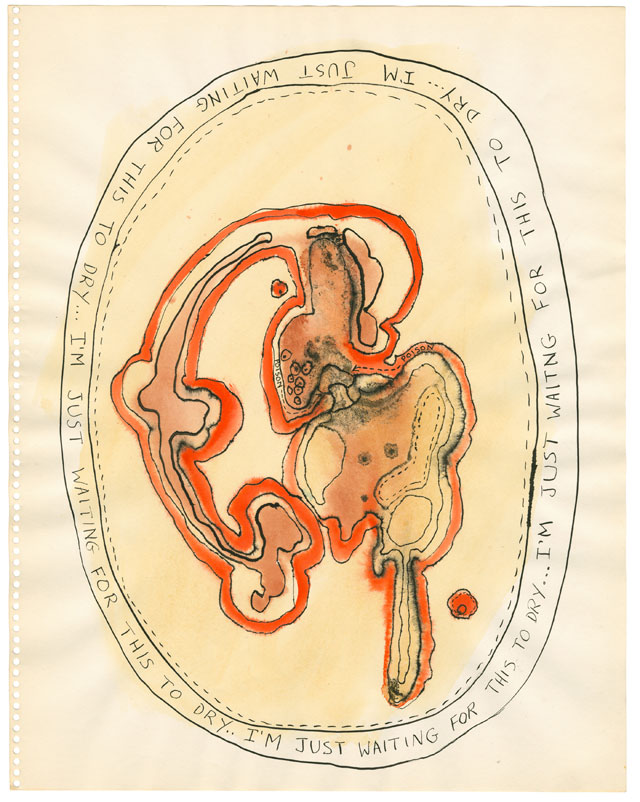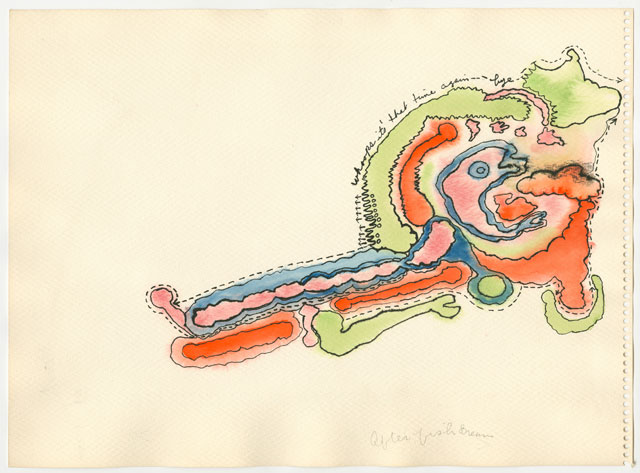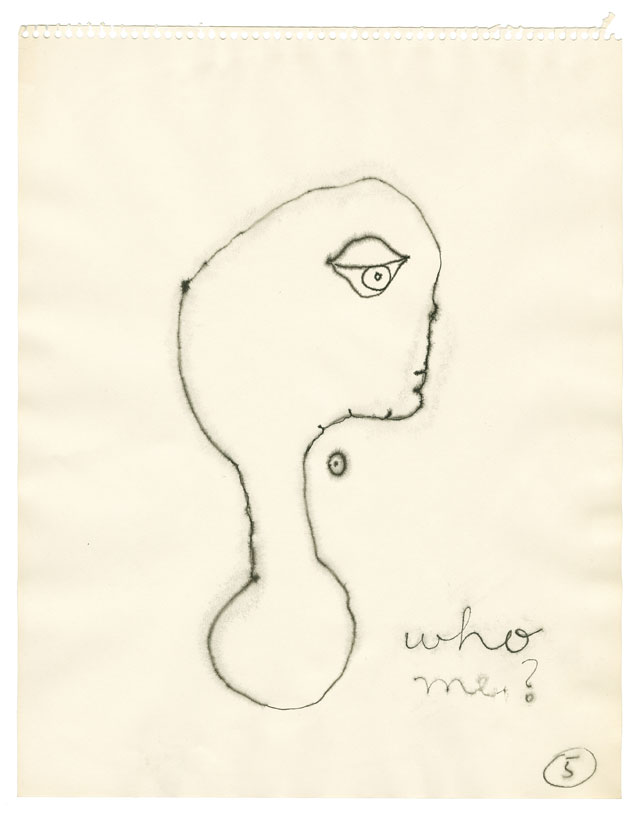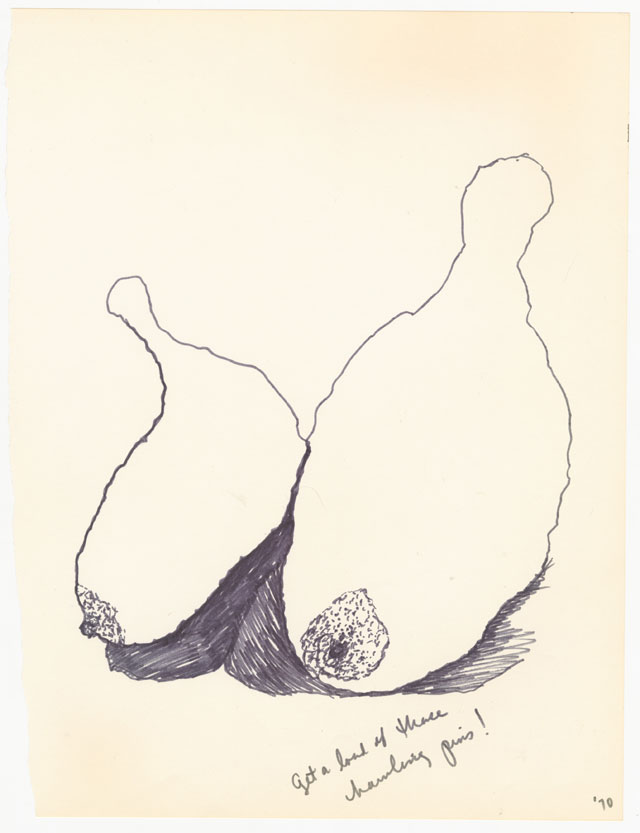
Hauser & Wirth, London
19 May – 29 July 2017
by ANNA McNAY
In 1969, Ida Horowitz (b1929), a struggling artist and mother of four, recently moved from Chicago to San Diego, was driving her two young sons to the zoo when suddenly she felt herself unravelling. She was unable to tell red from green, and her children had to guide her through set upon set of traffic lights. Later that day, recognising the danger, she checked herself into the mental health ward of Mercy Hospital.
Ida – who went on to become the internationally successful feminist artist Ida Applebroog (a made-up surname adopted when she felt the need to distance herself from both her maiden name, Appelbaum, and her married name, Horowitz) – had with her a sketchbook. During her six-week stay on the ward, she filled this with drawings and scribbled thoughts, and it is these excavations of her mind that now – after 40 years buried in a basement locker, until they were rediscovered by a studio assistant in 2009 – fill the walls of Hauser & Wirth London’s south gallery in a revealing and insightful show.

Ida Applebroog. Mercy Hospital, 1969. Ink and watercolour on paper, 35.6 x 27.9 cm (14 x 11 in). © Ida Applebroog. Courtesy the artist and Hauser & Wirth. Photograph: Emily Poole.
There is an intimacy to these works, which are displayed unframed, with torn perforations down the side of each page, and were clearly never intended for public consumption. Fresh, raw and naive, the ambiguous, amorphous, porous forms are bodily, anatomical, like diagrams of the brain, or Louise Bourgeois’ bloody, seeping pregnant forms. Bodies are trapped within larger bodies, confined, restrained. In one, hands are joined, umbilically, accompanied by the scribbled words: “Hey, who says all marriages are made in heaven?” The works are untitled, and it is these scrawled annotations that give us clues to the thoughts running through Applebroog’s mind as she created each drawing, colouring them with pastels, watercolour, or blotted ink, oozing across the outlines, escaping boundaries, unwilling to be defined.

Ida Applebroog. Mercy Hospital, 1969. Watercolour, ink and pencil on paper, 27.9 x 38.1 cm (11 x 15 in). © Ida Applebroog. Courtesy the artist and Hauser & Wirth. Photograph: Emily Poole.
Many of the lines are dashed, hesitant, incomplete – carrying a sense of someone waiting for the dots of her life to be joined up. As much as they are anatomical, so these drawings are geographical – maps of uncharted terrains, as Applebroog set forth on her journey of self-discovery, sowing the seeds of her successful artworks to come. Many of these would be built on extracts from her journals, questioning the power relations that had previously so controlled her life. Born in the Bronx in 1929, Applebroog was brought up by illiterate Orthodox Jewish parents – a depressed mother and a dominant and terrifying furrier father, who did not even permit her to tear a sheet of toilet paper on the Sabbath. As a child, Applebroog was painfully shy, and this endured throughout her life, with an ability to talk to others and attend openings developing only in recent years (the artist is now 87). “My whole life had been based on silence,” she reveals in a documentary film made by her daughter, Beth B, in 2016. “For me, silence was company.” This might go some way also to explaining the overwhelming headlessness – and ensuing mouthlessness – of her androgynous figures and puppets.

Ida Applebroog. Mercy Hospital, 1969. Ink on paper, 35.6 x 27.9 cm (14 x 11 in). © Ida Applebroog. Courtesy the artist and Hauser & Wirth. Photograph: Emily Poole.
There is a clear sense of struggle in these drawings – “this way … no that way … come this way … no that way …” – and of the questioning of identity, both in terms of gender (“You a girl or a boy?”) and nationality (“Not made in America”). One asks directly: “So what does it all mean?”, while another calls out a plaintive “NO!”, with a cross on one foot, a tick on the other, as if to denote the enforcement of being right or wrong, with the artist seeking to place the correct foot forward. Elsewhere a hand reaches up for help. But the most revealing of all drawings contains the name “IDA”, trapped inside some organic mass, floating in a sea of “Why”s, annotated by the words: “A day of no sense; drawings of no sense; keep drawing, painting, working … is this what keeps me alive? or is this what makes me so ill? why must I? why must I? why must I? why must I? why? why?”

Ida Applebroog. Mercy Hospital, 1969 – 1970. Pantone marker on paper, 34.6 x 26.7 cm (13 5/8 x 10 1/2 in). © Ida Applebroog. Courtesy the artist and Hauser & Wirth. Photograph: Emily Poole.
Some of the pages have been grouped together to form larger polyptychs on the gallery walls. A row of seven particularly foetal illustrations, with the vertebrae so acutely exaggerated that the writhing shapes appear reptilian, includes one page annotated as “the mutation”. It concludes with a drawing of a figure bent double with a heavy load on its back, labelled: “That ain’t no monkey on my back.” The suggestion of Sisyphus’s struggle and eternal torment echoes how trapped one might postulate the 40-year-old Applebroog felt as a suburban housewife and mother, not yet able to nurture her creative talent.
When Applebroog was discharged from Mercy Hospital, she moved to her own apartment and dedicated herself to her art. It seems the new Ida had found her form, if not yet her voice. As one of the more positive drawings – a hand, with the fingers numbered one to five – states: “5x2=10. 10 fingers like everyone else but oh so beautifully different … ‘I’ defy you … anyone to take that away from ‘ME’!” And looking back now,1 Applebroog, on the one hand not recognising or wishing to talk much about the hospital sketchbooks, on the other hand does concede: “The person who created these, I really do admire them.” And well she might.
Reference
1. Again in the documentary, Call her Applebroog, 2016, by Beth B.